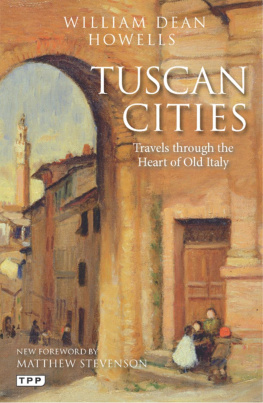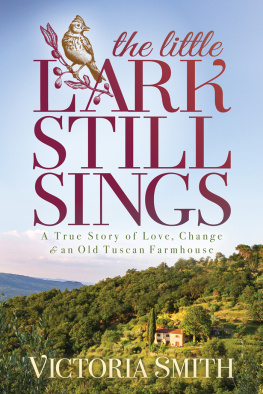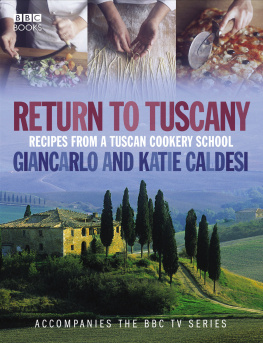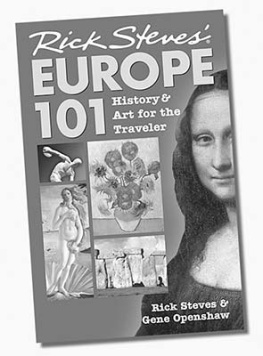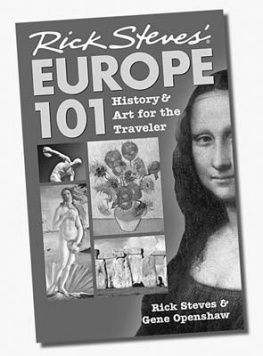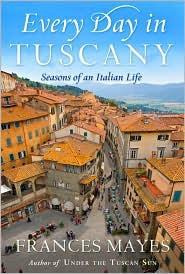Turning Tuscan
A Step-by-Step Guide to Going Native
Sam Hilt
With Poems by
Pamela Mercer
A Tuscany Tours Book

www.TuscanyTours.com
Copyright 2012 by Samuel Hilt. All rights reserved.
No part of this publication may be reproduced, distributed, or transmitted in any form or by any means, including photocopying, recording, or other electronic or mechanical methods, without the prior written permission of the publisher, except in the case of brief quotations embodied in critical reviews and certain other noncommercial uses permitted by copyright law. For permission requests, please contact the publisher.
Poems: Six Women Washing and The Equation of a Tree courtesy of Pamela Mercer
Cover Photo: Golden Gate Bridge courtesy of Siena Hilt
Cover design: Julius Broqueza
Digital conversions: Manisha Pagare
Table of Contents
Introduction
There are certain travel destinations like the Taj Mahal or the Great Wall of China that are fascinating to visit, but after you have a good look around, youre ready to go home. Then, there are other places that reach out seductively, that tempt you to consider what it would be like to actually live there. You begin fantasizing and scheming about how you could possibly pull it off. For most of us, lovely as the place may be, the fantasy dissipates by the time were back on the plane heading home. But, there are thosethe few, the brave, the insanewho find themselves so smitten by the paradise theyve found that they decide to jump ship and start a new life in new land.
This is a story about what its like to fall in love with Tuscany in your mid-life years, to buy a home there, to change around your work, and, finally, to leave the San Francisco Bay Area and move with your wife and children to a tiny Tuscan village. Thats the first part. The second part tries to share what its like living here once youve made the move: learning the language, becoming part of a village community, running a tour company, understanding the political scene, getting an internet connection, enjoying Renaissance art, spending time in the hospital, appreciating the bureaucracy, and enduring customer service at The Phone Company.
Ive tried to write it all in a way that will make you feel like an honored guest invited into the cockpit as we transfer from America to Tuscany and set up shop. And, in case youre wondering what kind of crazy person does such a thing, and whether you might be one, I try to share enough personal history and detail about our lives on both sides of the ocean to satisfy your curiosity.
This book has been written mainly during our fifth year of living full-time in our little village outside of Siena. It felt like just the right moment to attempt it, not too soon and not too late. As you live here, you move along an axis of integration where you begin as a total stranger and end up as a native. There are certain obvious cultural differences that you notice on your first day herethe way that people drink their coffee in a minute or two while standing at the bar; how narrow and crooked the streets are; how insanely people drive. Then, there are other areas that come into focus only slowly as you live here, begin to master the language and enter into the rhythms of daily life. You begin to notice conventions around cooking and eating, around forms of courtesy, around raising children, and a myriad of other things. These are not things that Italians can tell you about themselves; they are the cultural ground-rules and they remain largely invisible, like water to fish. But they constitute some of the most interesting and profound differences between living in America and living in Tuscany.
As a foreigner who enters into another culture, theres a limited window of time available to you to see these things and to try to record them in some way. You have to become Italian enough to play the game, but not so Italian yet that it all becomes invisible. If you wait too long, you are no longer in a position to reflect or comment on cultural differences because what people are doing seems totally normal to you.
Ripeness is all, as the poet said, and hopefully Ive managed to capture for you some of the subtler aspects of living here that travel photos, even high resolution ones, can never reveal.
Dedication
With love and gratitude to my wife, Pam, who chose with open eyes to embark on these fateful adventures, and to my daughters, Siena and Emma, who had no idea what they were getting into
Part I:
Inching Our Way Toward Tuscany

Figure 1: The author during his Italophile Brylcreem phase as a H.S. Senior
Newark and the I-talians
Even though weve now lived in Italy for a number of years, I still pause every now and then, stroke my beard reflectively and wonder how I ever managed to wind up here. I never dreamed of Italy when I was growing up in New Jersey. My family disdained spaghetti, and any fantasies about Europe that I harbored were focused on France. Italy was not in second place, or even in the top ten. When I reached college age and went off to Brandeis to study languages, I pursued French and Russian. I had little interest in Italian except for when my friends and I played at speaking the local dialect, as in Wuzza madda wichu, uh?
I also have to confess that having grown up in Newark, New Jersey, my notions of Italy were heavily influenced by certain preconceptions about Italians. (Anybody ever watch The Sopranos?) As a nice Jewish kid coming of age in the Weequahic section of Newark, the most important thing we learned about Italian kids was to avoid them as much as possible. We never went to their neighborhoods, and when they came to ours with their air of menace and bravado, we gave them a wide berth.
Iridescent shirts with high-roll collars, tight grey sharkskin pants, and pointy, shiny black shoes were standard issue dress. The guys had pompadour hairdos with a curl or wave protruding over the center of their foreheads that defied gravity in absolute ways. The girls built upward, ratting and spraying their hair so that it could stay upright and immobile come what may. After high school, we parted company: the Jewish kids went on to college while the Italian kids went mainly into the trades, or secretarial school or the family business.
My only visit to the Italian section of town took place when I was about 9 or 10 years old. My father had a barbershop on Chancellor Avenue in Newark, and his partner for several years was an Italian-American named Patsy. When Patsys daughter got married, we were all invited to the wedding. I entered a Catholic church for the first time in my life. I remember the shock of seeing statues of the saints all along the walls. An inner voice started screaming, Idols! They worship idols! Dont look at them! I stared at the ground throughout the entire service to avoid accidentally gazing upon the statues and making God angry. I was glad when it was all over. God, on the other hand, may have been amused by these inauspicious beginnings for someone who would wind up writing essays about Renaissance sculpture.
Early in my senior year I was chosen as one of two representatives from my social studies class to visit the Mayor of Newark on Good Citizenship Day. My female counterpart and I entered the august sanctuary of City Hall in fear and trembling. We wandered the corridors looking for the Mayors office and caught a glimpse of a portly man in a dark blue vest with a gold watch chain as he disappeared into one of the rooms.


